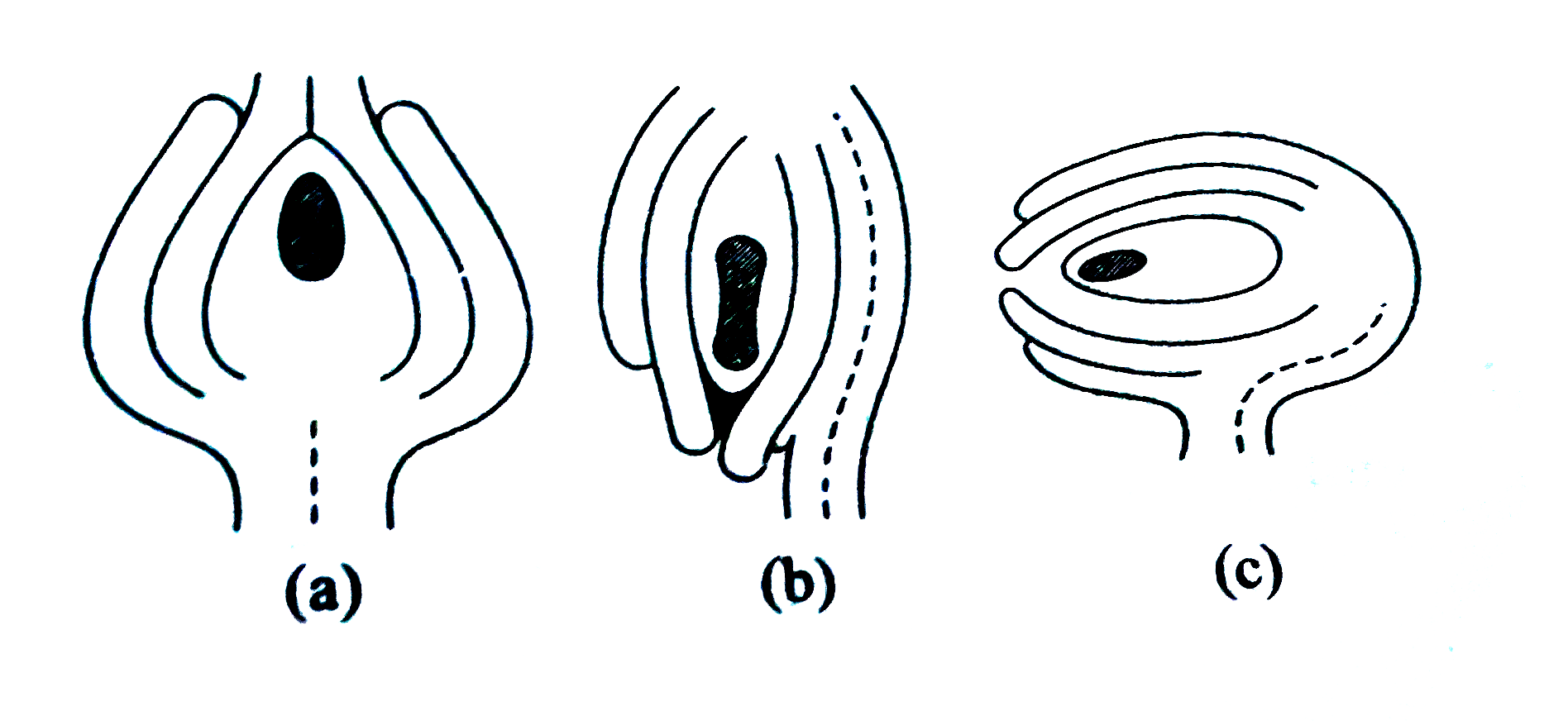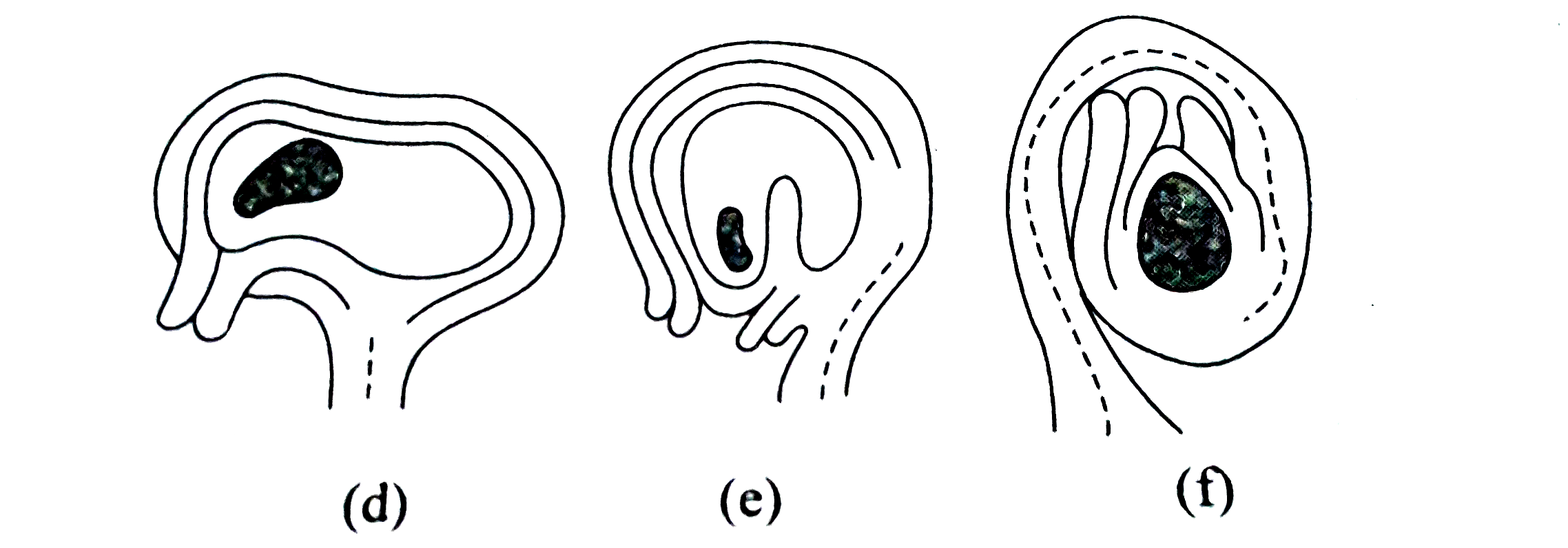Ovule is inverted with body fused to funicle, micropyle lying close to hilum and facing the placenta. It is
A
Hemitropous
B
Orthotropous
C
Anatropous
D
Campylotropus
Video Solution
Text Solution
The correct Answer is:C
Ovules are of 6 types :
1. Orthotropous (Atropous) ovule
∗ Orthotropous ovule is the most primitive type ovule.
∗ Ovule is straight and Micropyle, chalaza and funicle lies in a straight line or present at 180∘ or in one vertical plant.
e.g. : Most of gymnosperms like Cycas and primitive angiosperms like Nelumbo and Polygonum.
2. Anatropous ovule
∗ Anatropous ovule is the most common (82 % angiosperms) and most advanced type of ovule.
Ovule is inverted.
∗ Micropyle and chalaza lies in a straight line.
∗ Micropyle and funicle lies close to each other.
e.g. : Asteraceaee (most advance dicot family) and Solanaceae.
3. Hemitropous (half-inverted) ovule
∗ Micropule and chalaza lies in a straight line but both lies at 90∘ or perpendicular to funcile.
e.g. : Primulaceae and Rannunculaceae.
4. Campyotropour (body curved) ovule
∗ Body of ovule is curved.
∗ Embryo sac less curved and appears kidney shaped.
e.g. : Capsella and Pea.
5. amphitorpous ovule
∗ Both ovule and embryo sac curved and appears horseshpe shaped.
e.g. : Papaveraceae, Alisma
6. Circinotropous ovule
∗ Funicle coiled around the ovule.
e.g. : Opunia.


|
Updated on:21/07/2023
Topper's Solved these Questions
- BOOK - A2ZCHAPTER - SEXUAL REPRODUCTION IN FLOWERING PLANTS EXERCISE - Section C PREVIOUS YEARS' EXAMINATION QUESTIONS (AIIMS Question)s29videos
SEXUAL REPRODUCTION IN FLOWERING PLANTS
- BOOK - A2ZCHAPTER - SEXUAL REPRODUCTION IN FLOWERING PLANTS EXERCISE - Section D Chapter-end Test50videos
SEXUAL REPRODUCTION IN FLOWERING PLANTS
- BOOK - A2ZCHAPTER - SEXUAL REPRODUCTION IN FLOWERING PLANTS EXERCISE - Section B : (assertion-reasoning Questions)15videos
SEXUAL REPRODUCTION IN FLOWERING PLANTS
- BOOK - A2ZCHAPTER - REPRODUCTIVE IN ORGANISMSEXERCISE - Section D: Chapter-end Test50videos
REPRODUCTIVE IN ORGANISMS
- BOOK - A2ZCHAPTER - STRATEGIES FOR ENHANCEMENT IN FOOD PRODUCTIONEXERCISE - Section-d Chapter End Test50videos
STRATEGIES FOR ENHANCEMENT IN FOOD PRODUCTION
Similar Questions
Knowledge Check
- Question 1 - Select One
Ovule is inverted (resupinates at 180∘) with body fused to funicle, micropyle lying close to hilum and side by side with funicle facing the placent and is most common in Angiosperms. It is
AhemitropousBorthotropousCanatropousDcampylotropous - Question 2 - Select One
When the body of the ovule lies at right angles to the funicle and the micropyle lies close to the later, it is termed as
AanatropousBhemianatropousCcampylotropousDamphitropous - Question 3 - Select One
Mature ovules are classified on the basic of funiculus. If micropyle comes to lie close to the funiculus the ovule is termed as
AorthotropousBanatropousChemitropousDcampylotropous
The body of ovule is fused with funicle at a point called
View SolutionWhen ovule is straight with funiculus, embryo sac, chalaza and micropyle lying iin a straight vertical line, it is known as
View SolutionThe body of the ovule fuses with funicle in the region called
View SolutionThe body of the ovule fuses with funicle in the region called
View SolutionA: Anatropous ovule is resupinate ovule
R: The body of ovule is completely bent with hilum close to micropyalr endView Solution

